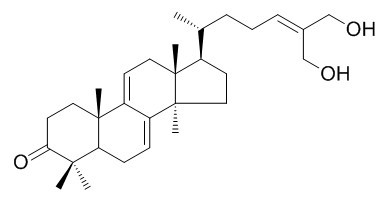Ganoderiol F
Ganoderiol F has anti-inflammatory, cytotoxic and anti-HIV activity, it inhibits activity of topoisomerases in vitro, and it inhibits human immunodeficiency virus-1 protease with IC(50) values of 20-40 microM. It induced HO-1 expression, activation of the mitogen-activated protein kinase EKR and up-regulation of cyclin-dependent kinase inhibitor p16 and suppressed lipopolysaccharide (LPS)-induced nitric oxide (NO) production.
Inquire / Order:
manager@chemfaces.com
Technical Inquiries:
service@chemfaces.com
Tel:
+86-27-84237783
Fax:
+86-27-84254680
Address:
1 Building, No. 83, CheCheng Rd., Wuhan Economic and Technological Development Zone, Wuhan, Hubei 430056, PRC
Providing storage is as stated on the product vial and the vial is kept tightly sealed, the product can be stored for up to
24 months(2-8C).
Wherever possible, you should prepare and use solutions on the same day. However, if you need to make up stock solutions in advance, we recommend that you store the solution as aliquots in tightly sealed vials at -20C. Generally, these will be useable for up to two weeks. Before use, and prior to opening the vial we recommend that you allow your product to equilibrate to room temperature for at least 1 hour.
Need more advice on solubility, usage and handling? Please email to: service@chemfaces.com
The packaging of the product may have turned upside down during transportation, resulting in the natural compounds adhering to the neck or cap of the vial. take the vial out of its packaging and gently shake to let the compounds fall to the bottom of the vial. for liquid products, centrifuge at 200-500 RPM to gather the liquid at the bottom of the vial. try to avoid loss or contamination during handling.
Cell Physiol Biochem.2019, 52(6):1255-1266
International J of Green Pharmacy2019, 13(3)
J Ginseng Res.2023, 47(4):593-603.
Applied Physics B2021, 127(92).
Int Immunopharmacol.2019, 71:361-371
Food Chem.2020, 327:126992.
Biomol Ther (Seoul).2019, 10.4062
Med Sci Monit.2019, 25:9499-9508
Front Microbiol.2023, 14:1232039.
Sci Rep. 2017, 12953(7)
Related and Featured Products
Toxicol Appl Pharmacol. 2014 Nov 1;280(3):434-42.
Anti-inflammatory and heme oxygenase-1 inducing activities of lanostane triterpenes isolated from mushroom Ganoderma lucidum in RAW264.7 cells.[Pubmed:
25239868]
Ganoderma lucidum is a popular medicinal mushroom used in traditional medicine for preventing or treating a variety of diseases.
METHODS AND RESULTS:
In the present study, we investigated the anti-inflammatory and heme oxygenase (HO)-1 inducing effects of 12 lanostane triterpenes from G. lucidum in RAW264.7 cells. Of these, seven triterpenes, butyl lucidenateE2, butyl lucidenateD2 (GT-2), butyl lucidenate P, butyl lucidenateQ, Ganoderiol F, methyl ganodenate J and butyl lucidenate N induced HO-1 expression and suppressed lipopolysaccharide (LPS)-induced nitric oxide (NO) production. Inhibiting HO-1 activity abrogated the inhibitory effects of these triterpenes on the production of NO in LPS-stimulated RAW264.7 cells, suggesting the involvement of HO-1 in the anti-inflammatory effects of these triterpenes. We further studied the anti-inflammatory and HO-1 inducing effects of GT-2. Mitogen-activated protein kinase inhibitors or N-acetylcysteine, an antioxidant, did not suppress GT-2-mediated HO-1 induction; however, LY294002, a phosphoinositide 3-kinase (PI3K) inhibitor, blocked GT-2-induced HO-1 mRNA and protein expression. GT-2 increased nuclear translocation of nuclear factor-E2-related factor 2 (Nrf2) and knockdown of Nrf2 by small interfering RNA blocked GT-2-mediated HO-1 induction, suggesting that GT-2 induced HO-1 expression via the PI3K/AKT-Nrf2 pathway. Consistent with the notion that HO-1 has anti-inflammatory properties, GT-2 inhibited the production of tumor necrosis factor-α and interleukin-6, as well as inducible nitric oxide synthase and cyclooxygenase-2 expression.
CONCLUSIONS:
These findings suggest that HO-1 inducing activities of these lanostane triterpenes may be important in the understanding of a novel mechanism for the anti-inflammatory activity of G. lucidum.
Chem Pharm Bull (Tokyo). 2009 Oct;57(10):1076-80.
Anti-human immunodeficiency virus-1 protease activity of new lanostane-type triterpenoids from Ganoderma sinense.[Pubmed:
19801861]
Five new highly oxygenated lanostane-type triterpenoids [ganoderic acid GS-1 (1), ganoderic acid GS-2 (2), ganoderic acid GS-3 (3), 20(21)-dehydrolucidenic acid N (4) and 20-hydroxylucidenic acid A (5)] were isolated from the fruiting body of Ganoderma sinense, together with known compounds including 6 triterpenoids and 3 sterols.
METHODS AND RESULTS:
The structures of the new triterpenoids determined by spectroscopic means including 2D NMR were 7beta-hydroxy-3,11,15-trioxo-lanosta-8,24(E)-dien-26-oic acid (1), 7beta,15alpha-dihydroxy-3,11-dioxo-lanosta-8,24(E)-dien-26-oic acid (2), 12beta-acetoxy-3beta,7beta-dihydroxy-11,15-dioxo-lanosta-8,24(E)-dien-26-oic acid (3), 3beta,7beta-dihydroxy-11,15-dioxo-25,26,27-trinorlanosta-8,20-dien-24-oic acid (4), and 7beta,20xi-dihydroxy-3,11,15-trioxo-25,26,27-trinorlanost-8-en-24-oic acid (5), respectively.
CONCLUSIONS:
Among these, ganoderic acid GS-2, 20-hydroxylucidenic acid N, 20(21)-dehydrolucidenic acid N and Ganoderiol F inhibited human immunodeficiency virus-1 protease with IC(50) values of 20-40 microM.
Life Sci. 2006 Aug 15;79(12):1129-39.
Ganoderiol F, a ganoderma triterpene, induces senescence in hepatoma HepG2 cells.[Pubmed:
16635496]
Ganoderiol F (GolF), a tetracyclic triterpene, was isolated from Ganoderma amboinense and found to induce senescence of cancer cell lines.
METHODS AND RESULTS:
GolF induced growth arrest of cancer cell lines HepG2, Huh7 and K562, but exerted much less effect in hepatoma Hep3B cells and normal lung fibroblast MRC5 cells, and no effect on peripheral blood mononuclear cells. GolF was found to inhibit activity of topoisomerases in vitro, which may contribute to the inhibition of cellular DNA synthesis. Activation of the mitogen-activated protein kinase EKR and up-regulation of cyclin-dependent kinase inhibitor p16 were found in early stages of GolF treatment and were presumed to cause cell-cycle arrest and trigger premature senescence of HepG2 cells.
CONCLUSIONS:
The growth-arrest and senescence induction capability on cancer cells suggest anticancer potential of GolF.



